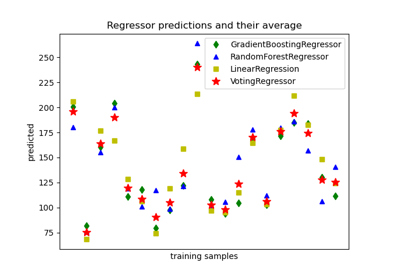sklearn.ensemble.VotingRegressor¶
-
class
sklearn.ensemble.VotingRegressor(estimators, *, weights=None, n_jobs=None, verbose=False)[source]¶ Prediction voting regressor for unfitted estimators.
A voting regressor is an ensemble meta-estimator that fits several base regressors, each on the whole dataset. Then it averages the individual predictions to form a final prediction.
Read more in the User Guide.
New in version 0.21.
- Parameters
- estimatorslist of (str, estimator) tuples
Invoking the
fitmethod on theVotingRegressorwill fit clones of those original estimators that will be stored in the class attributeself.estimators_. An estimator can be set to'drop'usingset_params.Changed in version 0.21:
'drop'is accepted. Using None was deprecated in 0.22 and support was removed in 0.24.- weightsarray-like of shape (n_regressors,), default=None
Sequence of weights (
floatorint) to weight the occurrences of predicted values before averaging. Uses uniform weights ifNone.- n_jobsint, default=None
The number of jobs to run in parallel for
fit.Nonemeans 1 unless in ajoblib.parallel_backendcontext.-1means using all processors. See Glossary for more details.- verbosebool, default=False
If True, the time elapsed while fitting will be printed as it is completed.
New in version 0.23.
- Attributes
- estimators_list of regressors
The collection of fitted sub-estimators as defined in
estimatorsthat are not ‘drop’.- named_estimators_Bunch
Attribute to access any fitted sub-estimators by name.
New in version 0.20.
See also
VotingClassifierSoft Voting/Majority Rule classifier.
Examples
>>> import numpy as np >>> from sklearn.linear_model import LinearRegression >>> from sklearn.ensemble import RandomForestRegressor >>> from sklearn.ensemble import VotingRegressor >>> r1 = LinearRegression() >>> r2 = RandomForestRegressor(n_estimators=10, random_state=1) >>> X = np.array([[1, 1], [2, 4], [3, 9], [4, 16], [5, 25], [6, 36]]) >>> y = np.array([2, 6, 12, 20, 30, 42]) >>> er = VotingRegressor([('lr', r1), ('rf', r2)]) >>> print(er.fit(X, y).predict(X)) [ 3.3 5.7 11.8 19.7 28. 40.3]
Methods
fit(X, y[, sample_weight])Fit the estimators.
fit_transform(X[, y])Return class labels or probabilities for each estimator.
get_params([deep])Get the parameters of an estimator from the ensemble.
predict(X)Predict regression target for X.
score(X, y[, sample_weight])Return the coefficient of determination \(R^2\) of the prediction.
set_params(**params)Set the parameters of an estimator from the ensemble.
transform(X)Return predictions for X for each estimator.
-
fit(X, y, sample_weight=None)[source]¶ Fit the estimators.
- Parameters
- X{array-like, sparse matrix} of shape (n_samples, n_features)
Training vectors, where n_samples is the number of samples and n_features is the number of features.
- yarray-like of shape (n_samples,)
Target values.
- sample_weightarray-like of shape (n_samples,), default=None
Sample weights. If None, then samples are equally weighted. Note that this is supported only if all underlying estimators support sample weights.
- Returns
- selfobject
Fitted estimator.
-
fit_transform(X, y=None, **fit_params)[source]¶ Return class labels or probabilities for each estimator.
Return predictions for X for each estimator.
- Parameters
- X{array-like, sparse matrix, dataframe} of shape (n_samples, n_features)
Input samples
- yndarray of shape (n_samples,), default=None
Target values (None for unsupervised transformations).
- **fit_paramsdict
Additional fit parameters.
- Returns
- X_newndarray array of shape (n_samples, n_features_new)
Transformed array.
-
get_params(deep=True)[source]¶ Get the parameters of an estimator from the ensemble.
Returns the parameters given in the constructor as well as the estimators contained within the
estimatorsparameter.- Parameters
- deepbool, default=True
Setting it to True gets the various estimators and the parameters of the estimators as well.
-
predict(X)[source]¶ Predict regression target for X.
The predicted regression target of an input sample is computed as the mean predicted regression targets of the estimators in the ensemble.
- Parameters
- X{array-like, sparse matrix} of shape (n_samples, n_features)
The input samples.
- Returns
- yndarray of shape (n_samples,)
The predicted values.
-
score(X, y, sample_weight=None)[source]¶ Return the coefficient of determination \(R^2\) of the prediction.
The coefficient \(R^2\) is defined as \((1 - \frac{u}{v})\), where \(u\) is the residual sum of squares
((y_true - y_pred) ** 2).sum()and \(v\) is the total sum of squares((y_true - y_true.mean()) ** 2).sum(). The best possible score is 1.0 and it can be negative (because the model can be arbitrarily worse). A constant model that always predicts the expected value ofy, disregarding the input features, would get a \(R^2\) score of 0.0.- Parameters
- Xarray-like of shape (n_samples, n_features)
Test samples. For some estimators this may be a precomputed kernel matrix or a list of generic objects instead with shape
(n_samples, n_samples_fitted), wheren_samples_fittedis the number of samples used in the fitting for the estimator.- yarray-like of shape (n_samples,) or (n_samples, n_outputs)
True values for
X.- sample_weightarray-like of shape (n_samples,), default=None
Sample weights.
- Returns
- scorefloat
\(R^2\) of
self.predict(X)wrt.y.
Notes
The \(R^2\) score used when calling
scoreon a regressor usesmultioutput='uniform_average'from version 0.23 to keep consistent with default value ofr2_score. This influences thescoremethod of all the multioutput regressors (except forMultiOutputRegressor).
-
set_params(**params)[source]¶ Set the parameters of an estimator from the ensemble.
Valid parameter keys can be listed with
get_params(). Note that you can directly set the parameters of the estimators contained inestimators.- Parameters
- **paramskeyword arguments
Specific parameters using e.g.
set_params(parameter_name=new_value). In addition, to setting the parameters of the estimator, the individual estimator of the estimators can also be set, or can be removed by setting them to ‘drop’.

